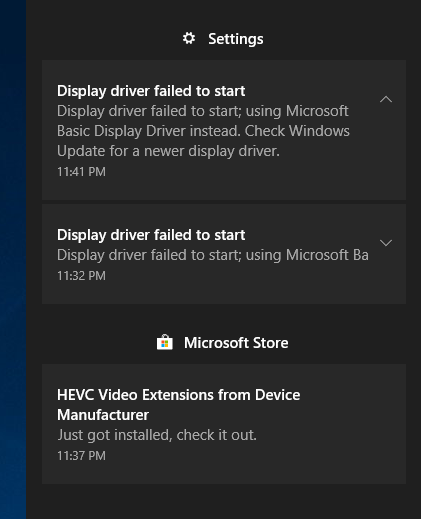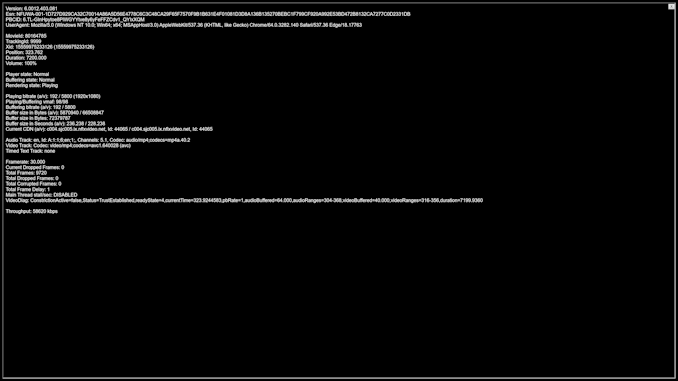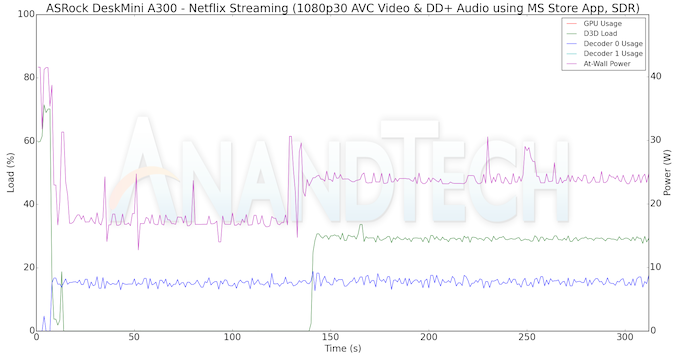The ASRock DeskMini A300 Review: An Affordable DIY AMD Ryzen mini-PC
by Ganesh T S on April 26, 2019 8:00 AM ESTHTPC Credentials - YouTube and Netflix Streaming
Streaming of 4K OTT content with YouTube and Netflix has become mainstream. HDR displays have also started becoming affordable. In order to evaluate YouTube HDR streaming support, we have the Mystery Box's Peru 8K HDR 60FPS video as our test sample. On PCs running Windows, it is recommended that HDR streaming videos be viewed using the Microsoft Edge browser after putting the desktop in HDR mode.
HDR content on YouTube is encoded exclusively in VP9 Profile 2. On systems supporting hardware accelerated decoding of VP9 Profile 2, Edge streams and decodes the HDR stream. The DeskMini A300 passes this test, and we can see HDR YouTube videos, as shown in the picture above.
Various metrics of interest such as GPU usage and at-wall power consumption were recorded for the first four minutes of the playback of the above video. The numbers are graphed below.
Decoding 4Kp60 VP9 Profile 2 videos consumes between 70 and 90% of one of the decoder engines. We also see some Direct3D loading of the order of 70% initially (when the stream being played back is at a lower resolution and needs to be upscaled to 4K). Once the stream stabilizes and the system starts decoding the 4K stream, the Direct3D loading settles around 50%. The average at-wall power consumption for streaming 4K YouTube HDR videos is around 33W.
4K HDR streaming in Netflix requires support for hardware-accelerated decoding of HEVC Main 10 videos. Microsoft removed the in-built HEVC decoding capabilities of Windows 10 in the 2017 Fall Creators Update, and replaced it with an extension that had to be downloaded from the Microsoft Store. Without the extension, playback is restricted to 1080p non-HDR streams encoded in H.264. In addition to the decoding capabilities, the system also needs to support PlayReady 3.0 DRM. In our tests with the Radeon 19.4.2 driver release, we ran into major problems.
Our usual testing flow involves the installation of the HEVC Video Extensions and the Netflix apps from the Microsoft Store. After configuring the Netflix login credentials, we attempt to play back Season 4 Episode 4 of the Netflix Test Patterns title. Unfortunately, the DeskMini A300 behaves in an unexpected manner when subject to the above steps. As soon as the playback of the title starts, the screen goes blank and the display driver crashes.
Windows reverts to the basic display driver, and the Netflix title continues to play back. However, instead of the expected 4Kp60 HEVC Main 10 stream (with HDR), we only get a 1080p30 AVC stream. In order to prevent the crashing of the driver in the course of our evaluation, we opted to uninstall the HEVC Video Extensions app, and make use of only the AVC decoder built into Windows. Without the HEVC Video Extensions, the driver has no problem with standard 1080p Netflix streaming. The OS screenshot facilities obviously can't capture the video being played back. However, the debug OSD (reachable by Ctrl-Alt-Shift-D) can be recorded.
The (avc) entry corresponding to the Video Track in the debug OSD, the Framerate (30.000), and with the A/V bitrate details (192 kbps / 5800 kbps) indicate that we are only getting a low quality 1080p stream compared to the best available one (4Kp60 16 Mbps HEVC Main 10 HDR stream). Similar to the YouTube streaming case, metrics such as GPU usage and at-wall power consumption were recorded for the first three minutes of the playback of the title. The numbers are graphed below.
1080p30 AVC playback is a walk in the park for modern computing systems. We see that the Direct3D loading is only around 30% and the decoder usage is less than 20% in the steady state. The former is mainly due The at-wall power consumption is around 24W for this workload.















88 Comments
View All Comments
BigMamaInHouse - Friday, April 26, 2019 - link
Comparing 2400G with Real iGPU vs $431 i7-8559U - I'd say it performs Great!.Irata - Friday, April 26, 2019 - link
To be more specific, on the "productivity benchmark", the A300 has 89% of the A310's score with 86% of its power consumption, so for office type tasks, it is actually a bit more efficient.ganeshts - Friday, April 26, 2019 - link
Ah, the pitfalls of saying ProdA scores X% of ProdB in metric M at Y% in metric N, when M and N are not linearly correlated!Extending it the same way, if I were to build the DeskMini 310 system with the same original review components at the current prices, I am going to splurge : 162 (DeskMini 310 board with Wi-Fi compared to DeskMini A300 without Wi-Fi) + 139 (Core i3-8100) + 76 (DDR4-2400 2x8GB SODIMM) + 78 (PCIe 3.0 x4 240GB NVMe SSD - Corsair Force MP510) = $455 ; Let me look up the table for the DeskMini A300 cost without Wi-Fi - tada, it is $465 - oh oh oh!!!! Does the lower upfront cost for the AMD system (as claimed in the article in the same BAPCo section) evaporate into thin air? No!
The reason is that when you are looking at SYSmark 2018 scores and SYSmark 2018 energy consumption numbers, you compare against systems that score approximately the same in those particular metrics.
For the overall SYSmark 2018 scores, the DeskMini A300 is approximately the same as the Baby Canyon NUC - then, let us look at the energy consumption numbers for those two - the Baby Canyon consumes lesser energy.
For the energy consumption numbers, the A300 and 310 are approximately in the same ball park - and there, you see the the 310 with a higher score.
As for accusations that 'Intel CAN"T be shown in anything other than their best light' - take a chill pill - the PCMark 8 numbers back up SYSmark 2018. And, in the gaming section, we show that AMD outperforms the best that Intel can offer. As an impartial reviewer, my aim is to present the facts as-is and provide my analysis - if you come with pre-conceived notions that one product / vendor is better than the other, then, no amount of facts will convince you otherwise.
Irata - Friday, April 26, 2019 - link
Replying to two different comments with one reply is a bit unfortunate as another poster made the "Intel can't be shown in..." comment.As for the price, if you check Newegg, the $150 A300 does include a Wifi kit.
Looking at Newegg prices, I get the following:
Desk Mini 300: $150
Desk Mini 310: $168
Ryzen 2400G: $150
Core i3-8100: $142
Memory: 100 (for the AMD system) vs. 80 (for the Intel based one)
note: I had a hard time finding the exact memory so I was looking at Team Group memory with roughly the same specs
WDS500G1B0C: $78
Corsair FORCE MP500: $130
When possible, in stock retail items with free shipping were chosen.
This gives me a total of $ 478 for the Desk Mini 300 (including WiFi) and $ 520 for the 310. But calling the price even would be OK, considering how prices can fluctuate.
MASSAMKULABOX - Monday, December 9, 2019 - link
AMd 150 + 150 +100 = $400INT $168 + 142 + 80 = $ 390 ... makes Intel cheaper , ..altho at this late date you can get the 2400g for $120 or less
Irata - Friday, April 26, 2019 - link
Second reply as I wanted to keep things separately.As I stated below, the comment regarding Intel having to be shown in the best light was made by another poster. Why could (she) have said this ?
For one, Intel is a client of your parent company Purch. They even mention this on their web site under "experience", stating "We’re focused on serving our action-oriented audience, as well as elevating the sponsor’s brand with that audience. We tailor the Native content that runs across our sites to better suit each environment, while keeping the integrity of the sponsor’s original content and brand."
In addition, you are using Bapco Sysmark, a benchmark that - given this "organization's" history - leaves a rather bad taste.
Now, I am not attacking your personal or journalistic integrity, however you must admit that the though AT may not be impartial does cross ones mind.
And this does not have to be overly obvious shilling (as that would be counter productive), but can be small nuances or tones, stressing one thing while leaving out another.
Do I have a pre-concieved notion of which one is better ?
Besides seeing the Intel iGPU as inferior (with the exception of video encode / decode) not really, but I admit that I do not particularly like Intel as a company
Ryan Smith - Friday, April 26, 2019 - link
"Now, I am not attacking your personal or journalistic integrity, however you must admit that the though AT may not be impartial does cross ones mind."Above all else, I think people vastly overestimate both how much work vendors are willing to put in, and how much they actually care about AnandTech. Being underhanded is a lot of work, especially for as small an audience as AnandTech has.
To be sure, there is a significant editorial firewall up between ad sales and editorial. I honestly couldn't even tell you about our (former) publisher's comments, because none of that ever involved AnandTech. It was probably a campaign that ran on Tom's Guide or such.
But regardless, we don't do shenanigans, and I won't stand for them. Vendors don't get to see articles early, we don't let vendors buy preferential treatment, and any sponsored content is going to be very clearly labeled as such. All AnandTech has its its honesty; so to sacrifice that would cost us everything.
Which, to loop back to the discussion of Sysmark, Ganesh uses it as part of his mini-PC evaluations. It's a pretty useful benchmark, especially for the energy efficiency metrics. It works well for what Ganesh needs, and the workloads seem reasonable. At the same time we're well-aware of the controversy surrounding it, and we'd never trust a single benchmark for a review - and certainly not Sysmark. Which is why we run many benchmarks, to look at different workloads and get different points of view on performance.
Irata - Saturday, April 27, 2019 - link
Thanks for the clarification Ryan. I still think that Sysmark is a no-go, but that's just my personal opinion.Smell This - Friday, April 26, 2019 - link
*As an impartial reviewer*_____________________
I snorted.
BPB - Friday, April 26, 2019 - link
I have one of these, and really like it. My problem is I bought this to replace an older NUC, and the older NUC runs Windows 8.1. I use the older NUC for WMC. Obviously the DeskMini doesn't support 8.1, but I thought I could get it to run 7. I can't. I noticed that ASRock has a utility for installing Windows 7 on AM4 motherboards, and I was given the impression that ASRock would update the DeskMini BIOS so I could install Windows 7. Then I found out the 2400G is only Windows 10 compatible. I don't know how I missed that when I did my research... So, my son gets nice little PC to replace his older one. This is a nice little setup, I just wish Windows 10 had something even 80 percent as good as WMC.